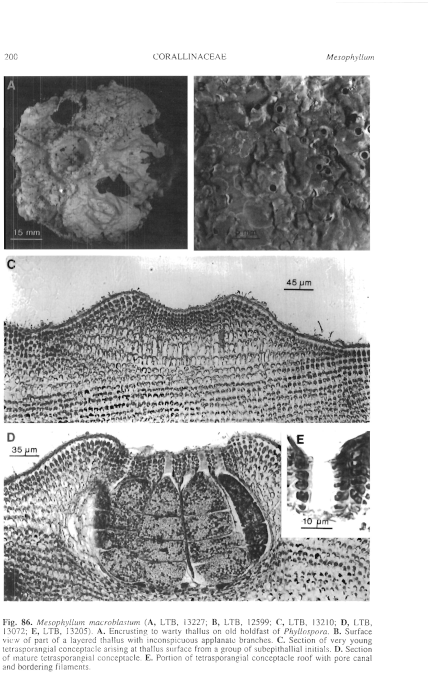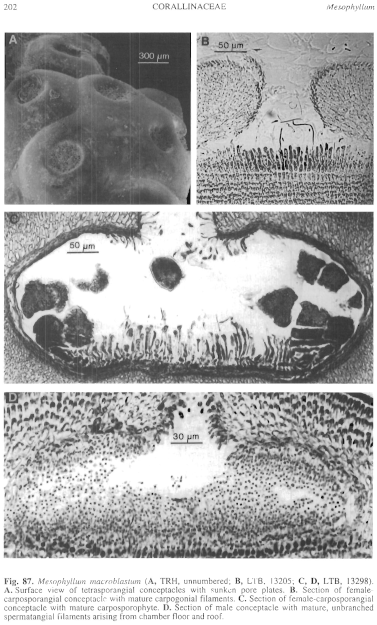|
|
|
|
|
|||||||||||
|
Electronic Flora of South Australia Species Fact Sheet
Phylum Rhodophyta – Class Florideophyceae – Order Corallinales – Family Corallinaceae – Subfamily Melobesioideae
Selected citations: Woelkerling & Harvey 1993: 590, figs 17–23.
Synonyms
Lithothamnion macroblastum Foslie 1897: 16. Woelkerling 1993: 140.
Additional references involving these binomials are provided by Woelkerling & Harvey 1993.
Thallus normally pinkish, encrusting to warty, somewhat lumpy or layered, mostly 30–85 mm across and 0.1–20 mm thick or tall, epigenous and partially to completely affixed by cell adhesion; protuberant branches simple, mostly 0.9–10 mm in diameter and 1.3–6 mm long; lamellate branches inconspicuous and tightly applanate, mostly 2–10 mm across and 2–14 mm long. Structure pseudoparenchymatous; organisation dorsiventral in crustose portions and lamellate branches but radial in protuberant branches; construction monomerous, consisting of a single system of branched, laterally cohering, filaments that collectively contribute to a ventrally or centrally situated core and a peripheral region where portions of core filaments or their derivatives curve outwards towards the thallus surface; each filament composed of cells 4–12 µm in diameter and 5–42 µm long; epithallial cells 3–5 µm in diameter and 3–6 µm long, terminating most filaments at the thallus surface, with distal walls rounded or flattened but not flared; cell elongation occurring mainly within actively dividing subepithallial initials that are usually as long as or longer than their immediate inward derivatives; cells of adjacent filaments joined by cell-fusions; secondary pit-connections, haustoria, and trichocytes unknown.
Reproduction: Vegetative reproduction unknown. Gametangia and carposporophytes produced in uniporate conceptacles; tetrasporangia/bisporangia produced in multiporate conceptacles.
Gametangial thalli monoecious or dioecious; carpogonia and spermatangia produced in separate conceptacles. Carpogonia terminating 2- or 3-celled filaments arising from the female conceptacle chamber floor. Mature female-carposporangial conceptacle roofs protruding above surrounding thallus surface, 80–205 µm thick, composed of 12–30 layers of cells above the chamber; conceptacle chambers 175–540 µm in diameter and 54–270 µm high. Carposporophytes lacking a conspicuous central fusion cell and consisting of an irregularly shaped fusion cell (not always evident) that may look discontinuous in section, and several-celled gonimoblast filaments bearing terminal carposporangia 40–85 µm in diameter. Spermatangial filaments unbranched(?), arising from the floor, walls and roof of male conceptacle chambers; mature male conceptacle roofs protruding above surrounding thallus surface, 62–108 µm thick, composed of 11–16 layers of cells above the chamber; conceptacle chambers 243–310 µm in diameter and 65–105 µm high.
Tetrasporangial/bisporangial conceptacle roofs protruding above surrounding surface, differentiated into a peripheral rim and a central sunken pore-plate, 4–5 cells thick above the chamber; pore canals lined by cells that are similar in size and shape to other roof cells; conceptacle chambers 145–270 µm in diameter and 90–150 µm high; tetrasporangia/bisporangia scattered across the conceptacle chamber floor; each mature sporangium 29–81 µm in diameter and 81–135 µm long, containing zonately arranged tetraspores or bispores and possessing an apical plug that blocks a roof pore prior to spore release.
Type from Gulf of Naples, Italy; holotype in TRH (unnumbered; includes slide 191); depicted in Woelkerling & Harvey (1993, p. 623, fig. 17A); additional data provided by Woelkerling (1993, p. 140).
Selected specimens: Head of Great Australian Bight, S. Aust., reef pools (Womersley, 4.ii.1954; AD, A19649 = LTB, 13707). Snapper Point, Kangaroo I., S. Aust. (Campbell & Penrose, 13.iv.1988; LTB, 15656). Robe, S. Aust., 3–6 m deep (Baldock, 15.v.1967; AD, A31493 = LTB, 13667). Red Rock Bay, Carpenter Rocks, S. Aust. (Shepherd, 26.i.1978; LTB, 12599). Cape Northumberland, S. Aust. (Shepherd, ii.1977; LTB, 11419). Port Fairy, Vic. (Woelkerling, 4.i.1979; LTB, 11436, 11720, 11721). Rye (Number Sixteen reef), Vic., reef pools (Platt & Woelkerling, 21.xii.1982; LTB, 12620 and Harvey & Condon, 11.ii.1993; LTB, 16596). Walkerville, Vic., 0–3 m deep (Woelkerling et al., 30.xi.1983; LTB, 13906, 13917, 13923 (in error cited as 13293 in the legend to Fig. 22 in Woelkerling & Harvey 1993)). Binalong Bay, Tas., 0–4 m deep (Platt, 23.ii.1983; LTB, 13205, 13210). Bluestone Bay, Freycinet Pen., Tas., 0–4 m deep (Plan, 12.ii.1983; LTB, 13072). Eaglehawk Neck (Clydes I.), Tas., 0–6 m deep (Plan, 26.ii.1983; LTB, 13298, 13311). Eaglehawk Neck (Tessellated Pavement), Tas., 0–2 m deep (Plan & Woelkerling, 26.ii.1983; LTB, 13225, 13227). North shore, Safety Cove, Port Arthur, Tas., 0–3 m deep (Platt & Woelkerling, 25.ii.1983; LTB, 12831). Sister Bay, Southport, Tas., 3–4 m deep (Platt et al., 16.ii.1983; LTB, 12877).
Distribution: Mediterranean shores of France and Italy.
In southern Australia, from the Head of the Great Australian Bight, S. Aust., to Walkerville, Vic., and the eastern and southern coasts of Tasmania.
Taxonomic notes: Mesophyllum macroblastum has been found in intertidal reef pools and subtidally to depths of 15 m on rock, glass, and the holdfasts of the brown algae Ecklonia and Phyllospora in southern Australia. Gametangial and tetrasporangial thalli may occur in the same populations, but isolated tetrasporangial thalli appear to occur more commonly. Bisporangia were found in one collection (LTB, 15656). Although most spermatangial filaments appear unbranched (Fig. 87D), one male conceptacle in LTB, 13298 recently examined by Derek Keats and the author appears to contain a branched spermatangial filament near the centre of the conceptacle chamber floor. Studies of mature and developing males in additional populations are required before the taxonomic significance of this observation can be fully assessed. Except for the type, records of occurrence in the Mediterranean require confirmation.
References:
ADEY, W.H. (1970). A revision of the Foslie crustose coralline herbarium. K. norske Vidensk. Selsk. Skr. 1970 (1), 1–46.
FOSLIE, M. (1897). On some Lithothamnia. K. norske Vidensk. Selsk. Skr. 1897 (1), 1–20.
WOELKERLING, W.J. & HARVEY, A. (1993). An account of sourthern Australian species of Mesophyllum (Corallinaceae, Rhodophyta). Aust. Syst. Bot. 6, 571–637.
WOELKERLING, Wm.J. (1993). Type collections of Corallinales (Rhodophyta) in the Foslie Herbarium (TRH). Gunneria 67, 1–289.
The Marine Benthic Flora of Southern Australia Part IIIB complete list of references.
Publication:
Womersley, H.B.S. (28 June, 1996)
The Marine Benthic Flora of Southern Australia
Rhodophyta. Part IIIB. Gracilarialse, Rhodymeniales, Corallinales and Bonnemaisoniales
Reproduced with permission from The Marine Benthic Flora of Southern Australia Part IIIB 1996, by H.B.S. Womersley. Australian Biological Resources Study, Canberra. Copyright Commonwealth of Australia.
Illustrations in Womersley Part IIIA, 1996: FIGS 86, 87.

Figure 86 enlarge
Fig. 86. Mesophyllum macroblastum (A, LTB, 13227; B, LTB, 12599; C, LTB, 13210; D, LTB, 13072; E, LTB, 13205). A. Encrusting to warty thallus on old holdfast of Phyllospora. B. Surface view of part of a layered thallus with inconspicuous applanate branches. C. Section of very young tetrasporangial conceptacle arising at thallus surface from a group of subepithallial initials. D. Section of mature tetrasporangial conceptacle. E. Portion of tetrasporangial conceptacle roof with pore canal and bordering filaments.

Figure 87 enlarge
Fig. 87. Mesophyllum macroblastum (A, TRH, unnumbered; B, LTB, 13205; C, D, LTB, 13298). A. Surface view of tetrasporangial conceptacles with sunken pore plates. B. Section of female-carposporangial conceptacle with mature carpogonial filaments. C. Section of female-carposporangial conceptacle with mature carposporophyte. D. Section of male conceptacle with mature, unbranched spermatangial filaments arising from chamber floor and roof.

|
Email Contact: State Herbarium of South Australia |

|